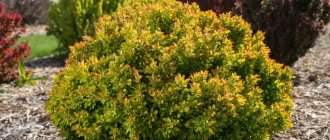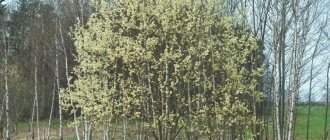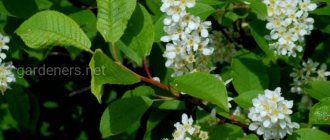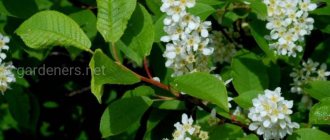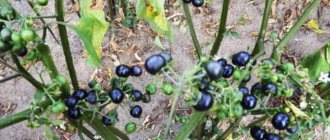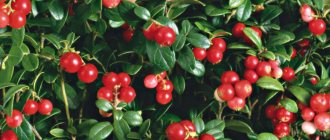Lingonberry (lat. Vaccinium vitis-idaea) is an evergreen chemophyte plant from the genus Vaccinium (lat. Vaccinium), widespread in Eurasia and North America. In the Allgäu Alps it is found up to an altitude of 2350 m above sea level. The first plantations of cultivated lingonberries, covering an area of several hectares, appeared in Scandinavia in the early 1960s. In Sweden it was grown to produce lingonberry jam. Other important breeding areas were in the republics of the former Soviet Union: Belarus and the Baltic states.
The plant prefers coniferous forests with acidic soil and is sensitive to frost: damage occurs at temperatures from -22 °C. However, throughout the world it is found not only within the temperate climate zone, but also in regions with winter temperatures down to -50 °C (71 ° N, Greenland and even further north). Such advancement into zones of continental, arctic and alpine climates became possible due to the presence of snow cover, which protects plants from hypothermia. Their height depends on the thickness of the snow layer.
Photo: Lingonberry berries
general characteristics
Lingonberry is an evergreen shrub with creeping rhizomes. This plant is very small - straight branched stems rarely grow higher than 30 cm. On the outside, the rounded leaves are shiny and dark green, on the inside they are light with brown dots. In spring, flowers with a weak but very pleasant aroma appear on short lingonberry stems. By the end of summer they are replaced by coral berries with reddish-brown seeds. Lingonberry is a perennial plant. Some specimens can bear fruit for almost 300 years. It grows best in forests, swamps, and thickets of arctic and subarctic regions. This plant is “related” to cranberries and blueberries, but is richer in nutritional components. Does well on acidic soils in Greenland, Siberia, the Caucasus, northern Asia, Scandinavia, Canada, and North America.
Description of the plant
Vaccinium vitis-idaea is a creeping or erect dwarf shrub 10–40 cm high. The aerial parts are covered with fluff. The length of the roots reaches 1 m. The leaves, consisting of a short petiole (approx. 1 mm) and a blade, are located alternately on the branches, in two rows. The plates are simple, leathery, 0.7–2 cm long and 4–8 mm wide, have an elliptical or obovate shape and a wedge-shaped base.
The upper side of lingonberry leaves is dark green, shiny, smooth or pubescent. The lower one is completely covered with glandular hairs. The edges are curved back. In drooping cluster-shaped inflorescences from 1 to 1.5 cm long, from 2 to 20 flowers are collected. The quickly falling bracts are broadly ovate, about 1 mm long.
Photo: how Lingonberry grows
Dark red flower buds open in late May - early August. Hypanthium naked. Bisexual, radially symmetrical flowers have a double perianth. The four sepals are broadly triangular, 1 mm long. The bell-shaped corolla is formed from four white or slightly pinkish fused petals 4–6.5 mm long. The eight pubescent stamens are about 0.5 mm long, and the anthers are about 1.5 mm long.
5-6 weeks after fertilization, at the end of August - beginning of September, bright red berries ripen, which are white when unripe. Under favorable conditions, cultivated varieties produce a second harvest in September and October. In the Netherlands, ripe lingonberries can sometimes be found at the end of June. Round, four-chambered berries with a diameter of 5–10 mm have a sour, slightly bitter taste. The white pulp contains numerous red-brown seeds up to 2 mm long.
Although lingonberries often grow in close proximity to blueberries, a hybrid between the two species, which botanists call hybrid blueberries (Latin: Vaccinium × intermedium), is rare.
Interesting facts 1. The Karelian-Finnish epic poem “Kalevala” tells how the maiden Maryatta, having eaten just one lingonberry, became pregnant and gave birth to a son, who turned out to be wise from birth and had greater strength than the first man and great hero Väinämöinen.
2. In the Canadian province of Newfoundland and Labrador, an average of 96,500 kg of wild lingonberries (subspecies Vacinium vitis-idea subspc. minus) are harvested annually, making this region the record holder in North America. Most of the fruits are quickly frozen and exported.
What are the benefits of lingonberries?
Content:
- general characteristics
- What are the benefits of lingonberries?
- For some it’s berries, for others it’s medicine.
- Benefits for the body
- How our grandmothers treated themselves with lingonberries
- Possible danger
- Culinary ideas
In many countries they know the legend about lingonberries, which in ancient times tried to explain where this small berry, growing in poor northern soil, got so many useful substances from. So, the legend tells about a swallow that carried living water in its beak. The bird dreamed of showering people with this magical liquid and giving them immortality. But bad luck - the swallow was stung by a wasp. In pain, the bird opened its beak and living water spilled out. Life-giving drops fell on three plants - pine, cedar and lingonberry. Since then they have become evergreen and have healing powers.
Some may say: this is just a beautiful fairy tale, with not a grain of truth behind it. But there is truth, and it is that lingonberries really have amazing life-giving powers. And all this is thanks to the rich chemical composition of these forest berries.
Researchers who studied the composition of lingonberries say that with a low calorie content (only 43 kcal per 100 grams), it serves as a rich source of fiber, glucose, vitamins A, and magnesium, calcium, phosphorus, potassium, and omega-3 fatty acids. It contains an impressive amount of flavonoids and lignins, which, according to scientists, are powerful anti-cancer agents. Another substance that protects humans from malignant tumors is quercetin. And lingonberries are second only to blueberries in terms of the content of this useful substance. The berry also contains benzoic acid, which is no less useful and is known for its antimicrobial properties. All of them determine the healing abilities of the berry.
Varieties for the climate of the Urals
It is known that some varieties of lingonberries are deliberately bred for harsh winters. In the climatic conditions of the Urals, the following varieties may be promising:
- Miss Cherry;
- Kostromichka;
- Kostroma pink;
- Red Pearl;
- Ruby;
- Sanna.
In addition to healing berries, lingonberries look great in the garden. This suggests that by planting miniature bushes, you can get double benefits: benefit and beauty.
For some it’s berries, for others it’s medicine.
In herbal medicine, lingonberry leaves and fruits are used. Preparations from the greenery of the plant are usually used as diuretics and disinfectants. Due to the rich content of tannins, they have bactericidal and anti-inflammatory properties. The catechins contained in the plant make it useful for strengthening capillaries and preventing microhemorrhages. In many folk recipes, lingonberry leaves are used to treat gastritis, liver diseases, and gout.
Fresh fruits are recommended for people with hypertension and poor eyesight. And folk healers attributed the mixture of berries and honey to those suffering from tuberculosis.
Being a rich source of ascorbic acid and other vitamins, this northern berry is useful for pregnant women, as it improves the condition of the nervous system, muscles (which is important for a healthy birth), strengthens the skeleton of the expectant mother and her child, and also maintains healthy hemoglobin levels.
Residents of the North use this berry to treat diabetes, cardiovascular diseases, fever, kidney dysfunction, some digestive disorders, and edema.
This red berry is considered one of the richest sources of polyphenols and has an anti-sclerotic effect. Like most of its “sisters”, it can increase the level of good cholesterol and stabilize blood pressure.
Chemical composition
Active ingredients
The stems contain phenols and their derivatives (arbutin); leaves - aldehydes, triterpenoids (ursolic acid), vitamin C, arbutin, phenolcarboxylic acids, catechins, tannins, flavonoids. The fruits contain carbohydrates (8-10%), organic acids (citric, malic, benzoic, quinic, tartaric, salicylic, lactic, succinic, etc. - 2-2.7%), pectin substances (0.63%), vitamins C (7-32 mg •%), PP, essential oil, anthocyanins, salts of potassium, calcium, magnesium, phosphorus, iron. The seeds contain quick-drying fatty oil (32%), the leaves contain arbutin (6-9%), tannins (2-9%).
Benefits for the body
Quercetin and anti-inflammatory effect
In folk medicine, lingonberries are also known as a natural remedy for pain caused by inflammation, including rheumatoid arthritis. Finnish scientists, wanting to scientifically explain this phenomenon, studied the composition of the berries. It turned out that lingonberries contain an extremely high concentration of quercetin, a flavonoid with a strong anti-inflammatory effect.
Medicine for recurrent urinary tract infections
Lingonberry is one of the few foods that contain flavonoid compounds known as proanthocyanidins. These substances, when entering the human body, destroy bacteria that cause urinary tract infections. Including recurrent ones. The effectiveness of the medicine made from lingonberry juice was confirmed by 150 women who took part in a scientific study.
Lingonberry is considered the main natural medicine against cystitis.
The rich content of vitamins B2 and C, manganese, potassium and organic acids helps eliminate inflammatory processes in the bladder.
Cancer cell activity inhibitor
Lingonberries, as studies have shown, can slow down the spread of cancer cells throughout the body. In particular, its effectiveness has been proven for leukemia, cervical and colon cancer. The thing is that this berry is a product with amazing antioxidant properties. Lingonberries, to a greater extent than any other berries, contain flavonoids (antioxidant substances). When they enter the body, they destroy free radicals, preventing many diseases and early aging.
Oral hygiene product.
Inflammation of the gums can often cause not only tooth loss, but also the development of other seemingly unrelated diseases. The easiest way to prevent periodontal disease is to practice good oral hygiene. And lingonberries can play a decisive role in this matter. Possessing anti-inflammatory and antibacterial properties (think quercetin), this berry kills bacteria that cause periodontal disease.
Eliminates age-related pigmentation
Arbutin is an enzyme responsible for skin pigmentation.
In older people, arbutin concentrations decrease. But scientists have found plants that can serve as a source of this enzyme. And lingonberries are also on the list of berries that are useful for maintaining healthy skin pigmentation. To restore skin color, lingonberries can be consumed internally and as a natural cosmetic.
Growing
Agricultural technology
Work on the selection of large-fruited, productive forms of lingonberries is just beginning. However, abroad - in Sweden, Finland and other countries - there are already forms that provide a yield of 0.5 kilograms per square meter (the record is about 1 kilogram), substrates, propagation methods, and other agricultural techniques have been developed. Domestic experienced gardeners are given the opportunity, after observing the behavior of plants in natural plantings, to create identical conditions on their site, and most importantly, to notice in the forests plants with large, beautiful and tasty berries, productive, healthy, and multiplying quickly. The best berries are collected from these bushes, the seeds are isolated and used for sowing. The best time to sow is just after they are picked from the berries in late fall. Before spring sowing, seeds must be stratified for 2-3 months. Sow seeds on pre-prepared beds or in boxes. The soil surface is compacted before sowing, then slightly loosened, making it rough. Scatter the seeds and do not cover them with soil on top. The seeds undergo natural light treatment and germinate better. Crops must be watered regularly. Seedlings bloom for the first time in the 4th-5th year, sometimes at 10 years of age.
Reproduction
The best seedlings and selected forms are propagated by cuttings. They are cut in late autumn or early spring before shoots begin to grow. In the forest, this is done with great care and thrift, without causing damage to the natural clump and saving the cut shoots from drying out. The length of the cutting is 3-5 centimeters. The substrate is a mixture of sand and peat (1:2). The atmosphere is saturated with moisture in a greenhouse or greenhouse. The seedlings are used for planting in the fall of the same year. In a permanent place, on a moistened substrate of peat and sand (1:1), plants are planted in rows (the distance between them is 25 centimeters, between plants in a row is 10-20 centimeters). If there is a lack of planting material, the planting pattern is slightly different - 1x0.5 meters (1 meter between rows, 0.5 meters between plants). In this case, additional measures are required to stimulate growth. By the 3-4th year, the plants, growing, fill a bed up to 1 meter wide and produce 0.5-0.8 kilograms of very healthy berries per square meter.
How our grandmothers treated themselves with lingonberries
Lingonberries in folk medicine are usually present in the form of alcohol tinctures, water infusions and decoctions. Leaves, fruits, and roots are used to prepare medicine. By the way, lingonberry root tincture is a well-known remedy against colds and flu. And leaves and stems soaked in alcohol help against headaches, upper respiratory tract diseases and colds. Decoctions and lingonberry teas are often prepared for the treatment of urolithiasis, bleeding, and jaundice. Juice and decoction of berries helps get rid of vitamin deficiency and rheumatism. Such remedies are useful for strengthening the immune system, improving vision, diabetes, and stomach diseases. Below are several ancient recipes from traditional medicine.
For cystitis
Take a glass of boiling water per tablespoon of lingonberry leaves. Wrap up and leave for at least an hour. Take the finished product three times a day before meals, half a glass.
For urolithiasis
Add a glass of boiling water to about 40 g of crushed lingonberry leaves and simmer for 30 minutes in a water bath. Wait for the broth to cool, strain, add boiled water to make 200 ml of broth. Take 60 ml twice a day.
For chronic gastritis
Pour boiling water (1 cup) over a teaspoon of dry herbs and leave for an hour. Drink 50 ml three times a day half an hour before meals.
For constipation
Pour fresh berries with cold boiled water. Leave overnight. Take as a laxative.
For kidney, liver and colic diseases
Pour boiling water over a glass of fresh berries and add 400 ml of cold boiled water. Leave for 6 hours. Take 100 ml before meals 3-4 times a day.
For periodontal disease
In a water bath, prepare a decoction of 10 g of dry lingonberry leaves and a glass of boiling water (simmer for about half an hour). Judge, strain. Rinse the mouth for periodontal disease and stomatitis.
Planting in open ground
You can grow lingonberries in your garden, but this requires a lot of effort. The culture requires quality care. A special feature of lingonberry cultivation is its unpretentiousness to soil conditions. The culture requires a lot of sun and light. Lingonberries can be negatively affected by stagnation of water in the soil, darkening, and stagnation of cold air (when cultivated in hollows or pits).
Loamy and peat soils and soil with high acidity are suitable for cultivating lingonberries.
Grown bushes purchased from nurseries are suitable for planting. Before purchasing, seedlings are carefully inspected so as not to acquire a diseased bush.
Before planting lingonberries, the soil is prepared: the top layer of about 25 cm is removed, and the hole is completely filled with a nutrient substrate - peat, or a sand-peat mixture. It is recommended to add fallen needles from fir trees or pine trees to the composition of the soil. After compaction, the soil is watered with acidified water.
When planting lingonberries, holes are dug to a depth of only 2-3 cm, deepening the seedlings a short distance. A distance of about 20 cm is maintained between seedlings. The grown bushes quickly develop, forming a dense canvas on the surface of the soil.
Immediately after planting the seedlings, the soil around the bushes is compacted and then watered. In addition, the soil is mulched - covered with straw, pine needles, bark, sawdust or brick. Gravel or crushed bricks are rarely used as mulch.
Culinary ideas
Lingonberries freshly picked from the bush have a tart and sour taste, which not everyone likes. But many people love them in the form of jams, sauces, and syrups. One of the simplest ways to prepare lingonberries is to pour layers of berries and sugar into a jar. In this form, the fruits will retain optimal amounts of nutrients. And this syrup can be stored for quite a long time. If you don’t like whole berries, then try grinding them in a blender and mixing with sugar. This berry puree can also be stored in the refrigerator and added to tea, porridge, pancakes, and pies. And of course, don’t forget that sour wild berries are the best ingredient for making sauces for meat and wild poultry.
Lamb with lingonberry sauce
Ingredients:
- 2 tablespoons chopped thyme;
- 2 tablespoons of chopped parsley;
- 1 teaspoon chopped fresh rosemary;
- large clove of garlic;
- 2 teaspoons mustard;
- 5 tablespoons apple cider vinegar;
- lamb (2 pieces of 8 ribs each);
- half a teaspoon of salt;
- half a teaspoon of black pepper;
- chopped shallots;
- half a glass of lingonberries;
- half a teaspoon of butter;
- a little meat broth.
Mix thyme, parsley, rosemary, mustard and garlic in a saucepan, add a tablespoon of vinegar. Meanwhile, season the lamb with salt and pepper and fry over high heat until crust forms. Transfer the meat to a baking dish and sprinkle with the prepared spice mixture. Bake until done. While the meat is in the oven, mix the rest of the vinegar and shallots, bring to a boil, add broth (about half a glass), boil until the liquid is reduced by half. Add a little salt, black pepper and lingonberries (you can pour boiling water over them first). Stirring everything together, cook for about another minute. Remove from heat, add butter, stir. Serve lamb cut into portions with sauce.
Harvest and storage
Lingonberry leaves can be collected only before flowering begins (April-May), and only those leaves that have survived the winter should be selected. Young leaves are not suitable for drying; they will turn black. Or the harvesting of leaves can be postponed until the fall, when flowering is over. Only after 5-10 years can the next collection of leaves be carried out. The leaves should be spread out in a thin layer and dried in a dark, well-ventilated area, stirring from time to time. Properly dried leaves do not turn black, but remain green.
The berries are picked when they are well ripe, any debris is removed and washed. Next, many methods of winter storage are used. Dry, make preserves and jams, freeze in the freezer. When frozen, all vitamins are preserved. But it is worth remembering that when freezing it is important to use sealed bags, otherwise foreign odors will transfer to the berries.
Lingonberries make delicious jams and preserves. It is also used to prepare lingonberry sauce, which is served with meat dishes. Thanks to it, the taste of the dish is enhanced and digestibility is improved.
So, lingonberries, which are not at all difficult to grow, are a very valuable plant. This shrub is not only a good decoration for your garden, but also a storehouse of vitamins that will help you stay healthy.
Lighting
Good coverage of culture is a must. This may not be a completely open area, but the sun on it should not be in passing, but most of the day, otherwise, instead of amicable ripening, its yield will be piecemeal, like in a forest. It will also grow well in a shady place, but will have a purely decorative function.
The place should be well protected from the wind; in windy places, pollination, and therefore fruiting, will be weak, and in winter the snow necessary for shelter will be blown away.
Feeding
The requirements for fertilizers are minimal; it is enough to apply them once at the beginning of flowering, using exclusively mineral complexes, but with a reduced nitrogen content. From mineral fertilizers, it is better to choose those recommended for heather crops, for example, “Kemira-Universal”, “Sortvorin” or “Kemira-Lux”.
Organics such as chicken droppings or manure are contraindicated for lingonberries! It alkalizes the soil, which is unfavorable for the plant, and in addition, can lead to burns due to the high nitrogen content.
Flowers
Brown flower buds of lingonberries tend to open almost the entire fruiting period: from late May to August. The emerging flower has the shape of a bell or a white-pink pitcher; several bells-pitchers are collected in tassels. The corolla has a two-tier structure with 4 fused triangular petals in each row. Lingonberry flowering lasts 15 days. Bumblebees and bees are the main pollinators of lingonberries, but the plant can also self-pollinate. A month and a half after pollination, scarlet berries ripen.
Selection of planting material
It is important to choose the right variety for cultivation, taking into account the climatic conditions in the region. Most varietal specimens of domestic selection are suitable for the middle zone
Among the foreign varieties that grow in this climate are Sanna, Ida, Red Ammerland, Linnea, Susi, etc. For those who want to enjoy delicious fruits for a long time, it is recommended to take a closer look at the remontant lingonberry, which bears fruit twice a season. Among the best remontant varieties are Coral and Ruby.
Lingonberry seedlings are sold in containers and with open rhizomes. Planting material with closed roots can be planted throughout the growing season. If you follow the recommendations for planting and selecting a good site, such seedlings quickly take root and grow. They are transplanted into the garden or garden without destroying the earthen coma.
Open seedlings must be planted soon after purchase. During the purchase, you should evaluate their condition: carefully examine the rhizome, trunk, and root collar. All organs should look healthy, there should be no stains, growths, or rot on them. The root system must be well developed. Before transportation, to prevent the roots of the seedlings from drying out, they must be wrapped in moistened sphagnum moss.
